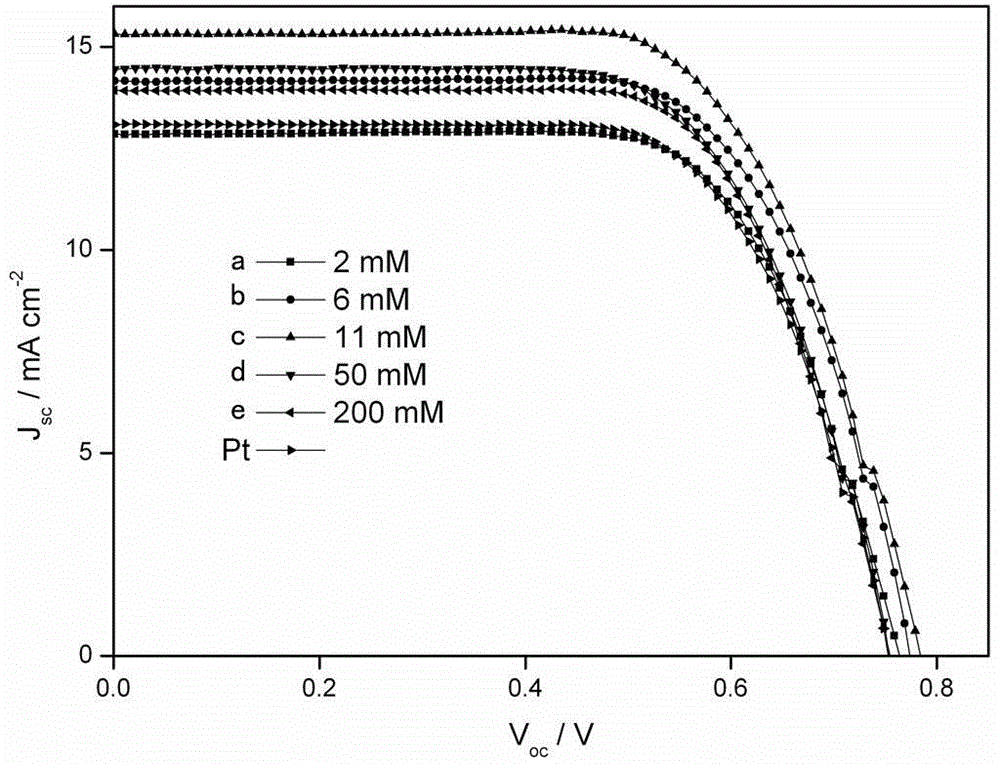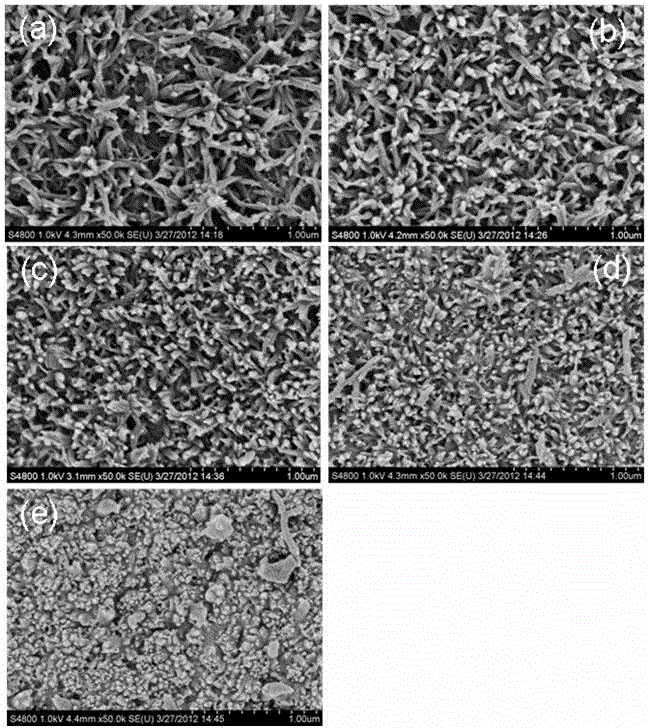Preparation method of polyaniline nanowire array counter electrode of dye-sensitized solar cell
A solar cell and dye-sensitized technology, applied in the field of dye-sensitized solar cells, can solve the problems of cumbersome experimental equipment or high-temperature sintering, harsh preparation conditions, high production costs, etc., achieve the best energy conversion efficiency, low price, and reduce comprehensive cost effect
- Summary
- Abstract
- Description
- Claims
- Application Information
AI Technical Summary
Problems solved by technology
Method used
Image
Examples
Embodiment 1
[0014] Add 2 mM aniline and 2 mM ammonium persulfate into a 1000 mL beaker, then add 1 mM hydrochloric acid and stir well, then put a thoroughly cleaned FTO conductive glass into the beaker, and conduct a hydrothermal reaction at 50 °C for 24 h. After the reaction, the hydrothermal kettle was naturally cooled to room temperature, and the conductive glass was taken out, rinsed and dried. Electron microscope photos such as figure 1 (a) shown.
[0015] This counter electrode was assembled into DSSCs according to the standard method, with a cell area of 0.2304 cm 2 . The current-voltage (I-V) curve of the dye-sensitized solar cell was measured under AM1.5 simulated sunlight ( figure 2 shown in curve 1), to obtain the open circuit photovoltage ( V oc ) is 760 mV, and the short-circuit photocurrent ( J sc ) is 12.85 mA / cm 2 , fill factor ( FF ) is 0.69, the energy conversion efficiency ( n ) is 6.73%. The current-voltage curve such as figure 2 (a) shown.
Embodiment 2
[0017] Add 6 mM aniline and 9 mM ammonium persulfate into a 1000 mL beaker, then add 2 mM benzenesulfonic acid and stir well, then put a thoroughly cleaned FTO conductive glass into the beaker, and conduct a hydrothermal reaction at 10 °C for 12 h. After the reaction, the hydrothermal kettle was naturally cooled to room temperature, and the conductive glass was taken out, rinsed and dried. Electron microscope photos such as figure 1 (b) shown.
[0018] This counter electrode was assembled into DSSCs according to the standard method, with a cell area of 0.2304 cm 2 . The current-voltage (I-V) curve of the dye-sensitized solar cell was measured under AM1.5 simulated sunlight ( figure 2 shown in curve 1), to obtain the open circuit photovoltage ( V oc ) is 780 mV, and the short-circuit photocurrent ( J sc ) is 14.16 mA / cm 2 , fill factor ( FF ) is 0.68, and the energy conversion efficiency ( n ) is 7.51%. The current-voltage curve such as figure 2 (b) shown.
Embodiment 3
[0020] Add 11 mM aniline and 10 mM ammonium persulfate into a 1000 mL beaker, then add 1.5 mM perchloric acid and stir well, then put a thoroughly cleaned FTO conductive glass into the beaker, and conduct a hydrothermal reaction at 0°C for 24 h. After the reaction, the hydrothermal kettle was naturally cooled to room temperature, and the conductive glass was taken out, rinsed and dried. Electron microscope photos such as figure 1 (c) shown.
[0021] This counter electrode was assembled into DSSCs according to the standard method, with a cell area of 0.2304 cm 2 . The current-voltage (I-V) curve of the dye-sensitized solar cell was measured under AM1.5 simulated sunlight ( figure 2 shown in curve 1), to obtain the open circuit photovoltage ( V oc ) is 780 mV, and the short-circuit photocurrent ( J sc ) is 15.33 mA / cm 2 , fill factor ( FF ) is 0.67, the energy conversion efficiency ( n ) is 8.01%. The current-voltage curve such as figure 2 (c) shown.
PUM
| Property | Measurement | Unit |
|---|---|---|
| energy conversion efficiency | aaaaa | aaaaa |
| energy conversion efficiency | aaaaa | aaaaa |
| energy conversion efficiency | aaaaa | aaaaa |
Abstract
Description
Claims
Application Information
 Login to View More
Login to View More - R&D
- Intellectual Property
- Life Sciences
- Materials
- Tech Scout
- Unparalleled Data Quality
- Higher Quality Content
- 60% Fewer Hallucinations
Browse by: Latest US Patents, China's latest patents, Technical Efficacy Thesaurus, Application Domain, Technology Topic, Popular Technical Reports.
© 2025 PatSnap. All rights reserved.Legal|Privacy policy|Modern Slavery Act Transparency Statement|Sitemap|About US| Contact US: help@patsnap.com


